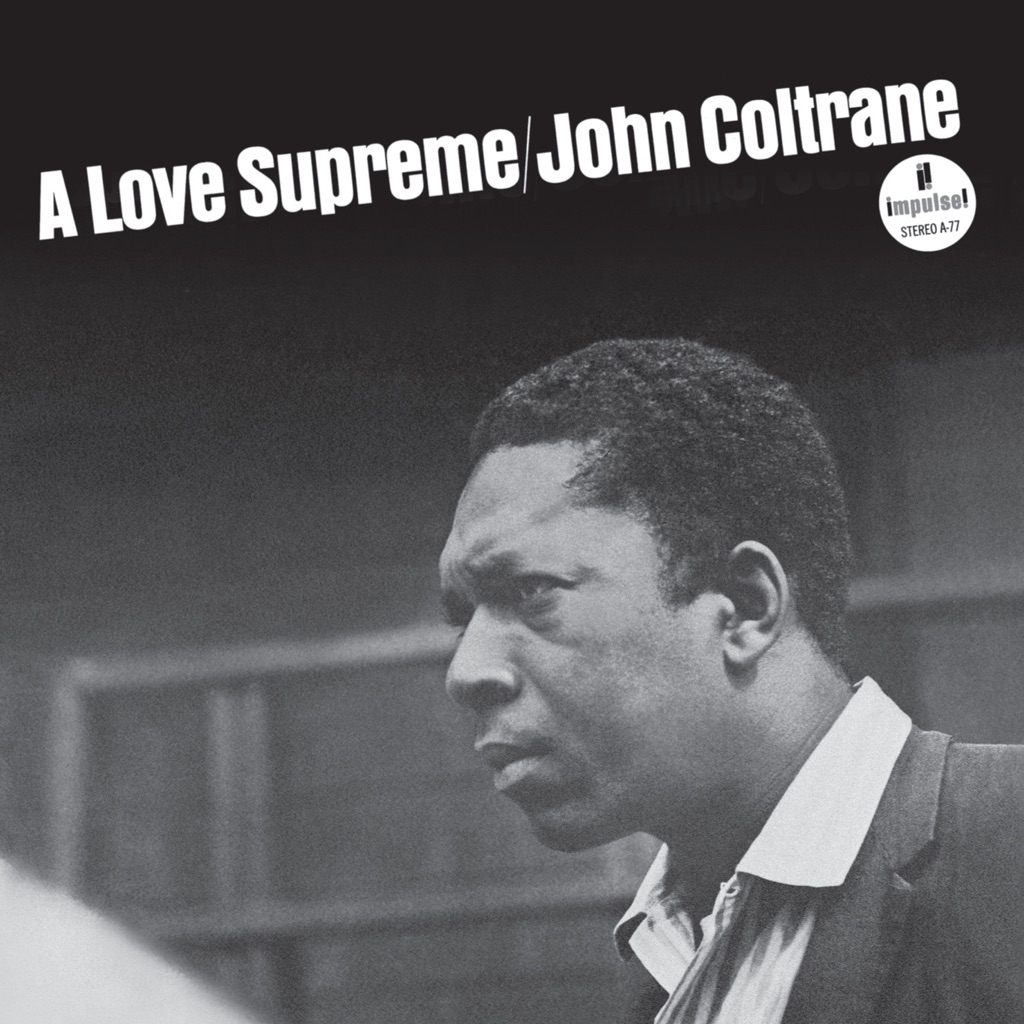
A Love Supreme
Recorded on December 9, 1964 in the iconic New Jersey studio of Rudy Van Gelder, *A Love Supreme* is the crowning achievement of John Coltrane’s Impulse period and arguably the most representative album by his classic quartet with pianist McCoy Tyner, bassist Jimmy Garrison, and drummer Elvin Jones. More than anything else, *A Love Supreme* raised the bar in terms of what jazz could strive to express. It is devotional in intent, with a long religious poem printed on the sleeve, and a liner note in which Coltrane alludes to his overcoming addiction (“a period of irresolution”) and pinpoints his “spiritual awakening” in 1957. (He doesn’t overtly mention his intensive work with Thelonious Monk that year, but it played a big role in his recovery and regaining of artistic focus.) There’s an aura of solemnity, therefore, surrounding *A Love Supreme*, and it’s clear from the first riveting notes of the opener, “Acknowledgement.” Here and throughout the album, there’s an evocative play between tempo and nontempo. Coltrane weaves incantational tenor sax phrases to begin, until Garrison takes up the main four-note “A Love Supreme” motif on bass and Jones drops a driving, multi-layered beat with the subtlest Afro-Latin tinge. Tyner’s spiky, transparent voicings help cement the rhythm before Trane enters again—six yearning notes systematically expanding into a turbulent sea of notes. That group sound, that moment, became etched into jazz history like scripture on a stone tablet. Coltrane ultimately sings the words “a love supreme” over the groove before the first movement gives way to “Resolution,” a surging, anthemic midtempo swing piece animated by one of Coltrane’s most powerful, noble melodic themes. “Pursuance” is much faster, bookended by Jones’ 90-second drum intro and Garrison’s full three minutes of deeply felt solo bass. “Psalm” then concludes the work with a tenor benediction, mournful and floating in time, with Tyner’s shimmering chords and Jones’ whooshing cymbals—in some sense reminiscent of “Alabama” from *Live at Birdland*. The full program is quite concise, although the Deluxe Edition tacks on the only known live version of the suite, plus alternate takes—two of which feature Archie Shepp and Art Davis on second tenor and bass, respectively, moving strongly in the direction of what would become *Ascension*. By 1964, Coltrane was long past the fast chord-change acrobatics of “Giant Steps” that had obsessed him in 1959. Following logically from his work with Miles Davis on *Kind of Blue*, he was exploring harmonic stasis, structures with far fewer chords, and a different way of organizing improvisational thought. This was “modal jazz,” which serves somewhat imprecisely to describe the music on *A Love Supreme*. It’s in a zone similar to “Impressions” from 1961, but it’s less abstract, more tonally based, than the famous “Chasin’ the Trane” from ’61 as well. It’s astonishing to think of what Coltrane achieved in 10 short years, between his debut as a leader in 1957 and his death from liver cancer in 1967 at age 40. The official lifetime releases don’t tell the whole story: From three posthumous albums we learn what the core *A Love Supreme* quartet was undertaking right after its December 1964 triumph. *Transition*, *First Meditations (for quartet)*, and *Sun Ship* give an indication of where Coltrane was leading the quartet post-*A Love Supreme*, had he chosen to stay on that route. Instead, in June of ’65 he recorded *Ascension*, a far more radical free improvisation with an expanded edition of the classic quartet. *Kulu Sé Mama* and *Meditations* also found Trane moving away from the textural sparsity of *A Love Supreme* while still retaining its core personnel. But by 1966, the classic quartet had dissolved. Though Garrison remained in place, Alice Coltrane and Rashied Ali entered on piano and drums, respectively. The music grew ever freer, edgier, more experimental, and a new classic quartet was born.
For the first time since 1992,Rolling Stone'sdefinitive classic returns to the scene, completely updated and revised to include the past decade's artists and sounds. When it comes to sorting the truly great from the merely mediocre, the enduring from the fleeting,The New Rolling Stone Album Guideprovides music buffs and amateurs alike with authoritative guidance from the best voices in the field. Filled with insightful commentary, it not only reviews the most influential albums of all time, but also features biographical overviews of key artists' careers, giving readers a look at the personalities behind the music.This fourth edition contains an impressive -- 70 percent -- amount of new material. Readers will find fresh updates to entries on established artists, hundreds of brand-new entries on the people and recordings that epitomize the '90s and the sounds of the 21st century -- from Beck to OutKast to the White Stripes and beyond -- along with a new introduction detailing changes in the music industry.Celebrating the diversity of popular music and its constant metamorphoses, with thousands of entries and reviews on every sound from blues to techno,The New Rolling Stone Album Guideis the only resource music lovers need to read.
